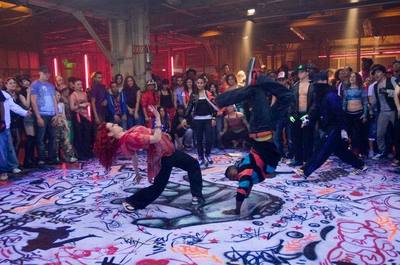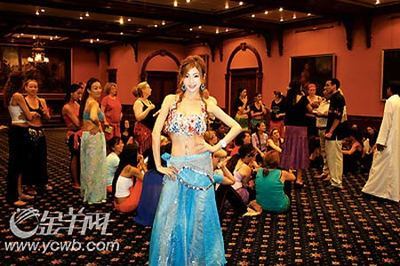a Cancan music
The can-can (more correctly not hyphenated, as in the original French:cancan) is regarded today primarily as a physicallydemanding music hall dance, performed by a chorus line of female dancers who wearcostumes with long skirts, petticoats, andblack stockings, that hearkens back tothe fashions of the 1890s. The main features of the dance are thelifting up and manipulation of the skirts, with high kicking and suggestive,provocative body movements.
The Galop from Jacques Offenbach's Orpheus in the Underworld is the tune mostassociated with the can-can (a somewhat simplifiedform).
Origins
The cancan first appeared inthe working-class ballrooms ofMontparnasse in Paris in around 1830. It was a more livelyversion of the galop, a dance in quick 2/4 time, which often featured as the finalfigure in the quadrille. The cancan was, therefore,originally a dance for couples, who indulged in high kicks andother gestures with arms and legs. It is thought that they wereinfluenced by the antics of a popularentertainer of the 1820s, Charles Mazurier, who was well known forhis acrobatic performances, which included the grand écart or jump splits—later a popularfeature of the cancan. At this time, and throughout most of the19th century in France, the dance was also known as thechahut. Both words are French, cancan meaning"tittle-tattle" or "scandal", hence ascandalous dance, while chahut meant "noise" or"uproar". The dance did causesomething of a scandal, and for a while, there were attempts torepress it. Occasionally peopledancing the cancan were arrested but it was never officiallybanned, as is sometimes claimed. Throughout the 1830s, it was oftengroups of men, particularly students, who caused the most outrageby dancing the cancan at public dance-halls.
As performers of the cancan became more skilled and adventurous,it gradually developed a parallel existence as entertainment,alongside the participatory form,although it was still very much a dance for individuals and not yetperformed on stage by a chorus line. A few men became cancan starsin the 1840s to 1860s, and an all-male group known as the Quadrilledes Clodoches performed the dance in London in 1870. But womenperformers were much more widely known in this period. They weremostly middle-ranking courtesans, andonly semiprofessional entertainers—unlike the dancers of the 1890s,such as LaGoulue and Jane Avril, who were highly paid for theirappearances at the Moulin Rouge and elsewhere. The female dancersof the Second Empire and the fin-de-siècle developed the variouscancan moves that were later incorporated by the choreographer Pierre Sandrini in the spectacular"French Cancan",which he devised at the Moulin Rouge in the 1920s and presented athis own Bal Tabarin from 1928. This was a combinationof the individual style of the Parisian dance-halls and thechorus-line歌舞队,合唱队 style of Britishand American music halls (see below).
Performance
The cancan is danced in 2/4 time, andis now usually performed on stage in chorus-line style. In Francein the 19th century the cancan remained a dance for individualentertainers, who performed on a dance floor. In the United Kingdom, the United States and elsewhere, the cancanachieved popularity in music halls, where it was danced by groupsof women in choreographed routines.This style was imported into France in the 1920s for the benefit oftourists, and the French Cancan was born—a highlychoreographed routine lasting ten minutes or more, with theopportunity for individuals to display their "specialities". Themain moves are the high kick or battement, the rond de jambe (quick rotary movement of lower leg with knee raised andskirt held up), the port d'armes (turning on one leg, whilegrasping the other leg by the ankle and holding it almostvertical), the cartwheel and the grand écart (the flying orjump splits劈叉). It has become commonpractice for dancers to scream and yelp while performing the cancan, but this is byno means essential.
There is also a men's cancan that uses the battement, along withbackflips,直体后空翻 cartwheels侧手翻, and splits; it is intended to showoff the dancer's energy and athletic ability.
Perception
The cancan is now considered anacceptable part of world culture, and often the main featureobserved today is how physically demanding and tiring the dance isto perform, but it still retainssomething of an erotic buzz for many. When the dance first appeared inthe early 19th century, it was considered little more than ascandalous activity that young people indulged in, similar to howrock and roll would be perceived later on. In the mid-19th century,when the dance was emerging from the working-class dance-halls intothe mainstream, it was thought to be extremely inappropriate by"respectable" society.[1] In thelate 19th and early 20th centuries the cancan was viewed as muchmore erotic because the dancers made use of the extravagant underwear of the period, and thecontrasting black stockings. They lifted and manipulated theirskirts much more, and incorporated a move sometimes considered themost cheeky and provocative—bendingover and throwing their skirts over their backs, presenting theirbottoms to the audience. The Moulin Rouge dancer La Goulue was wellknown for this gesture, and she had a heart embroidered on the seat of her drawers内裤.[2]
A Cancan dancer would sometimes stand very close to a man andbet that she could take off his hat without using her hands. Whenhe took the bet, she'd execute a high kick that would take off hishat--and give him a quick look at her undies while she was at it. This was a warning toanyone thinking of taking unwantedliberties冒犯的行为 with a cancan dancer that he could expect akick in the face.
It is a myth that the cancan was ever frequently danced withoutdrawers. This mistaken belief has taken root probably because whenthe cancan first appeared in working-class dance halls in the1830s, drawers were not a standard item of underwear. They wereadopted in the 1850s because of the advent of the hooped skirt or crinoline. Initially drawers were of the"open" type, being essentially two tubes of material, one for eachleg, and this is perhaps another reason for the myth. However, theMoulin Rouge management did not permit dancers to perform in suchrevealing garments.
Early editions of the Oxford Companion to Music defined the cancan as "Aboisterous and latterly indecorous dance of the quadrille order, exploitedin Paris for the benefit of such British and American tourists aswill pay well to be well shocked. Its exact nature is unknown toanyone connected with this Companion."
Inart
Many composers have written music forthe cancan. The most famous music is French composer JacquesOffenbach's galop infernal inOrpheus in theUnderworld (1858). Other examples occur in Franz Lehár's The Merry Widow (1905) and Cole Porter's musical play Can-Can (1954) which in turn formed thebasis for the 1960 musical film Can-Can starring Frank Sinatra and Shirley MacLaine. Some other songs that havebecome associated with the cancan include Khachaturian's Sabre Dance and the music hall standard Ta-ra-ra Boom-de-ay.
The cancan has often appeared in ballet, most notably Léonide Massine'sLa Boutique fantasque (1919) andGaîté Parisienne, as well as The Merry Widow. A particularly fine example can be seenat the climax of Jean Renoir's 1954 film French Cancan.
French painter Henri de Toulouse-Lautrec produced several paintings anda large number of posters of cancan dancers. Other painters to havetreated the cancan as a subject include Georges Seurat, Georges Rouault, and Pablo Picasso.
 爱华网
爱华网

